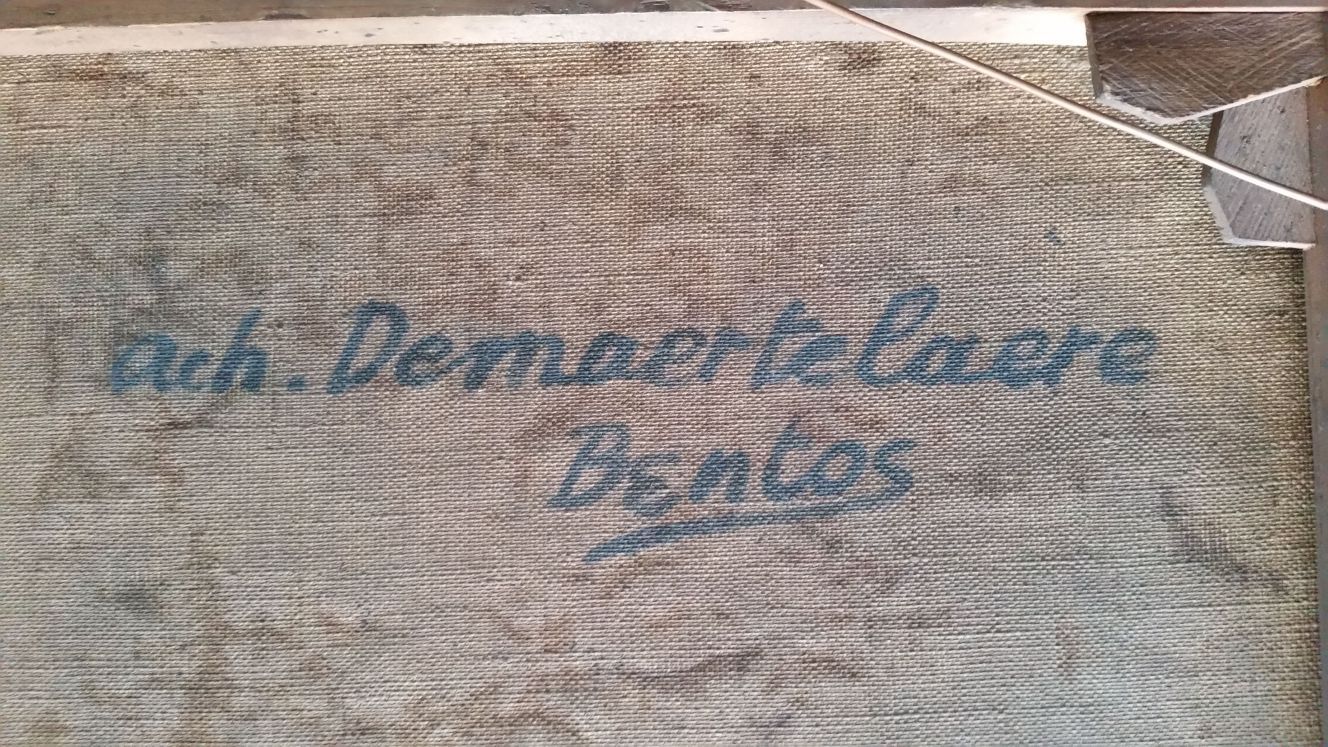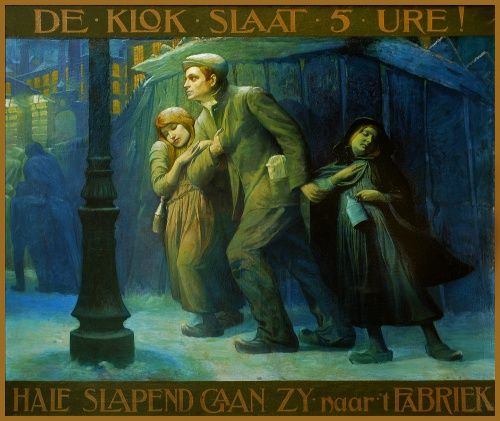Life and work of Achilles De Maertelaere - Bentos

Achilles De Maertelaere was born in Ghent (B) on September 5, 1882. He is the son of Karel (Carolus Ludovicus) De Maertelaere (1856-1940) and Pélagie Van Laecke (1856-1931). He has an older brother Polydoor (1881-1935), a younger brother Ernest (1886-?) and a younger sister Sylvie (1892-1989). A fifth child of the family, Sylvain, died shortly after his birth in 1890.

Achilles De Maertelaere has never been married and has had no children. He lived with his parents until 1931. When his mother died, he moved in with his father to the family of his sister Sylvie in the Prinsenstraat (now Mirabellostraat), in the Prinsenhof. He continued to live with his sister (first in Prinsenstraat, later in the Heldenplein in Malem) until his death on 24 April 1964.
His studio was located all his life in the Provenierstersstraat, 25, in the Old Beguinage Sint-Elisabeth. He will keep his studio there until about 1960-1961 when Achilles De Maertelaere was no longer able to continue his work due to age.
Why De Maertelaere became Bentos is explained in various contributions by the Ghendtsche Tydinghen: in the Old Beguinage lived another somewhat older artist with the name De Maertelaere (Edmond 1876-1938), which caused confusion. That is why he chose the slightly modified name of his friend Henri Bento, a circus artist who sometimes posed as a model and who he would have met in the sports club. Achilles De Maertelaere made the murals of his coffee house in the Lammerstraat (Café Bentos) for him. He will also paint two beautiful works where 'Henrietje', as Achilles De Maertelaere called him, reads the newspaper at home at the table and where his wife prepares the food. These paintings were hanging during the Second World War in Bentos' second café, on the corner of Wondelgemstraat and Filips Van Cleeflaan, where the café still exists.












Achilles De Maertelaere signed his works at the beginning of his career with his real name "Ach. De Maertelaere" (sometimes also Demaertelaere). He certainly did this until World War I: the poster for the 1913 World Fair is signed with his name. Also on the exhibitions of Art and Knowledge of 1912 and 1916, he is mentioned under the name Achilles De Maertelaere, while on the one of 1921 he exhibits with his artist name Achilles Bentos.
After the war this changed: he chose the artist name, certainly from the beginning of the 20s; indeed, the two war memorials of 1921 are both signed with resp. "Ach. Bentos D.M." and "Ach. Bentos". From then on he will bear the name Achiel Bentos, sometimes with the addition D.M. Rarely will he sign with his official name. On some works, we read the signature "Ahileo De Maertelaere" (in Esperanto).
According to some sources in Achiel De Maertelaere trained as a goldsmith. Actually, this 'profession' is mentioned in the register of the Academy for one single year (1895-1896). Before, the register mentions 'scholar' and later 'sculptor' and finally 'painter'.
What is certain is that he attended school at the Royal Academy of Fine Arts of Ghent from october 1894-95. He will win several first prizes there (Academic works). He will graduate there with two beautiful drawings that will also receive the first prize, in 1903-1904. In 1912 he competed for the triennial Prix de Rome for sculpting. 75 young artists applied. Achilles De Maertelaere was selected, together with five others, for the 'final competition'. Arthur Dupon will win the Rome Prize that year. Well-known artists will not bring it, that year, to the final competition, such as Eugène Canneel, Jozef Cantré (who made the monument of Edouard Anseele at the South in Ghent), Alfred Courtens, Oscar De Clerck, Oscar Jespers, Leon Sarteel or Victor Voets.


At the Academy he is a pupil of both father Jules E. Van Biesbrouck and his son Jules P. Presumably through their influence, Achilles is involved in the socialist movement in Ghent (socially engaged work). In his younger years, for example, he will be working on a number of large-scale murals for, among others, Ons Huis (Our House) in Ghent (Bond Moyson), for the people's house "De Zon" in Wetteren, etc. He will also design several posters for socialist events, such as the opening of Vooruit's warehouses in 1899. Although many of these works are not specifically dated, they seem to have to be placed before World War I. He will also make a portrait of Edouard Anseele (1856-1938) on the occasion of his 75th birthday in 1931. In 1934 he makes the funerary monument for trade union leader Jan Samijn.

The most iconic painting is undoubtedly the large canvas that was used for a while in the 1 May processions in Ghent, "The clock strikes 5 hours! Half asleep they go to the factory", that is now in the Floreal in Blankenberge.
The painting is still a symbol of the social struggle in Ghent, more specifically against child labour. Paule Verbruggen recently devoted an article to this work.

For the 1913 World's Fair Achilles De Maertelaere continued to work with the Van Biesbroecks. He painted a large canvas entitled "Allegory of the textile industry" which was exhibited in the vestibule. It now hangs in het Museum of Industry in Ghent. He also designed a poster for the 1st Socialist International Congress of Physical Education.
Achilles De Maertelaere was, probably under the influence of
his socialist ideas, an internationalist. He learned Esperanto and will sign
his works in Esperanto quite regularly. He will even make a series of (post-mortem?) portraits
of Ludwig L. Zamenhof (1851-1917), the founder of the Esperanto movement. There
are at least three portraits of Zamenhof. One painting in a
rectangular frame still hangs in the Esperanto Museum in Vienna (Austria),
while the other two are oval works. One beautiful sanguine is kept in the archives of AMSAB.

As an artist with a very academic style, Achilles De Maertelaere clearly did not follow the modoern developments in art. His themes (portraits, nudes, mythology) are top classics. He exhibited several times in the triennial Salons of Ghent (a.o. 1922, 1925, 1937) and was present several times at the exhibitions organised by Art & Knowledge (as Achilles De Maertelaere in 1912 and 1916, as Ach. Bentos in 1921, 1923, 1929, 1936 and 1937) and has participated in an art exhibition "Geluk in 't werk". The association (sometimes referred to as a popular society) included a gymnastics department, of which he was apparently a member.
He is one of the founders of the National Association of Painters and Sculptors of Belgium, which was founded in Ghent on 1 October 1922.
In January 1940 Achilles De Maertelaere was appointed teacher at the Academy of Fine Arts in Eeklo. He teaches modeling at the evening school and modeling and painting at the Sunday school. He resigns there in September 1951.
Achilles De Maertelaere dies in Malem (Ghent), at his sister's home, on 24 April 1964 at the age of 82. On his death, an article was published in Vooruit.


Translated with www.DeepL.com/Translator